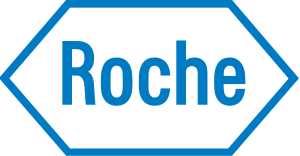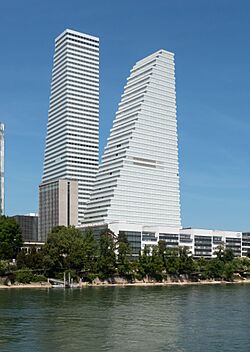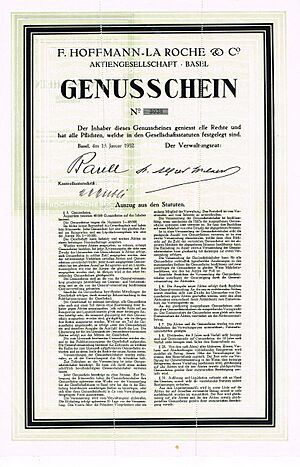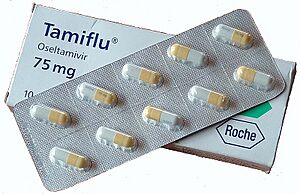Roche facts for kids
 |
|

Roche Tower and Roche Tower 2, headquarters of Hoffmann-La Roche in Basel (2022)
|
|
| Aktiengesellschaft | |
| Traded as | SIX: RO (voting) SIX: ROG (non-voting) |
| ISIN | [https://isin.toolforge.org/?language=en&isin=CH0012032048 CH0012032048] |
| Industry | Pharmaceuticals |
| Predecessor | Hoffmann, Traub & Co. (1894) |
| Founded | 1 October 1896 |
| Founder | Fritz Hoffmann-La Roche |
| Headquarters | Basel, Switzerland |
|
Area served
|
Worldwide |
|
Key people
|
|
| Products | Pharmaceuticals and diagnostics (List of products) |
| Revenue | |
|
Operating income
|
|
| Total assets | |
| Total equity | |
|
Number of employees
|
|
| Subsidiaries |
|
F. Hoffmann-La Roche AG, often called Roche, is a big Swiss healthcare company. It works all over the world. Roche has two main parts: Pharmaceuticals and Diagnostics.
Its main company, Roche Holding AG, has shares listed on the SIX Swiss Exchange. This means you can buy parts of the company. The main office is in Basel, Switzerland.
Roche is one of the largest pharmaceutical companies in the world based on its earnings. It is also a top provider of cancer treatments globally. In 2023, Forbes Global 2000 ranked Roche as the 76th biggest company in the world.
The company owns other important companies. These include the American biotechnology company Genentech and the Japanese company Chugai Pharmaceuticals. It also owns Ventana and Foundation Medicine in the United States. Roche's earnings in 2020 were 58.32 billion Swiss francs. The families who founded Roche, the Hoffmann and Oeri families, still own more than half of the company's voting shares. Roche is known for increasing its dividend (money paid to shareholders) every year. In 2020, it was the 34th year in a row!
F. Hoffmann-La Roche is a member of the European Federation of Pharmaceutical Industries and Associations (EFPIA).
Contents
How Roche Started and Grew
Roche was started in 1896 by Fritz Hoffmann-La Roche. Early on, the company was known for making different kinds of vitamins.
Early Discoveries and Challenges
- In 1934, Roche was the first company to make a lot of man-made vitamin C. They sold it under the name Redoxon.
- During World War II, Roche helped its Jewish employees move to the United States. This helped keep them safe.
- In 1957, Roche introduced a group of medicines called tranquilizers. Two well-known ones were Valium and Rohypnol.
- Roche makes and sells many medicines for cancer. They are a leader in this area.
- In 1956, the first antidepressant, iproniazid, was found by accident. Scientists were trying to make a better medicine for Tuberculosis. But they found that iproniazid made some people feel happier. It was later taken off the market because it had bad side effects.
- In 1976, there was an accident at a chemical factory in Seveso, Italy. This factory was owned by a company connected to Roche. The accident caused a lot of dioxin pollution.
Growing in the United States
- In 1982, Roche's US branch bought Biomedical Reference Laboratories. They combined it with their other labs to create Roche Biomedical Laboratories, Inc.
- By the early 1990s, Roche Biomedical became one of the biggest lab networks in the US.
- Roche has also made many HIV tests and medicines for HIV.
- In 1992, they bought the rights to a special science method called polymerase chain reaction (PCR).
- In 1995, a new era of HIV treatment began when the US approved Roche's HIV medicine, saquinavir. This medicine, and others like it, greatly reduced deaths from AIDS in the US.
- In 1995, Roche sold Roche Biomedical Laboratories, Inc. to another company.
Big Purchases and Partnerships
- Roche bought Syntex in 1994 and Chugai Pharmaceuticals in 2002.
- Oseltamivir (known as Tamiflu) is a medicine for the flu. Roche is the only company allowed to make it. They bought the rights to this medicine in 1996.
- In 2005, Roche decided to let other companies make Oseltamivir too.
- Also in 2005, Roche bought GlycArt Biotechnology. This helped them develop new medicines, like obinutuzumab, which helps treat a type of blood cancer.
- In 2008, Roche bought Ventana Medical Systems for $3.4 billion.
- A big step was in 2009 when Roche bought Genentech for $46.8 billion. Roche had already owned most of Genentech since 1990. After this, Genentech became a full part of Roche.
- Roche continued to buy many other companies over the years. These purchases helped them grow in areas like medical testing, cancer research, and gene therapy.
- In 2019, Roche bought Spark Therapeutics, a company that makes gene therapy medicines. One of Spark's medicines, Luxturna, treats a rare eye disease.
- In 2020, Roche Diagnostics got approval for a fast Sars-CoV-2 diagnostic test. This test could analyze many samples quickly.
- In 2021, Roche bought GenMark Diagnostics and TIB Molbiol to improve its medical testing abilities.
- In 2022, Roche acquired Good Therapeutics for its work on certain immune system treatments.
- In 2023, Roche partnered with Alnylam Pharmaceuticals for a hypertension drug and bought Carmot Therapeutics, a company developing anti-obesity drugs.
- Also in 2023, Roche teamed up with Monte Rosa Therapeutics to find new ways to fight cancer and brain diseases.
- In 2024, Roche sold one of Genentech's sites to another Swiss company, Lonza.
The Hoffmann-La Roche Family
The Hoffmann-La Roche family is one of the richest families in Switzerland. They are also known for being very private. Many family members now use different last names, such as Oeri, Michalski, Faber-Castell, Fabre, Schmid, or Duschmalé.
Companies Roche Has Bought
- Hoffmann-La Roche (Started in 1896 by Fritz Hoffmann-La Roche)
- Biomedical Reference Laboratories (Bought in 1982, became Roche Biomedical Laboratories, Inc in 1982, sold in 1995)
- Syntex (Bought in 1994)
- Chugai Pharmaceuticals (Bought in 2002)
- 454 Life Sciences (Bought in 2007)
- Roche Diagnostics
- Spring BioScience Corp (Bought in 2007)
- Ventana Medical Systems (Bought in 2009)
- mySugr GmbH (Bought in 2017)
- Viewics, Inc (Bought in 2017)
- Flatiron Health (Bought in 2018)
- Stratos Genomics (Bought in 2020)
- Memory Pharmaceuticals Corp (Bought in 2009)
- Genentech (Bought in 2009)
- Tanox, Inc (Bought in 2006)
- Arrayit Corporation (Bought in 2013)
- Seragon (Bought in 2014)
- Jecure Therapeutics (Bought in 2018)
- Medingo Ltd (Bought in 2010)
- BioImagene, Inc. (Bought in 2010)
- PVT Probenverteiltechnik GmbH (Bought in 2010)
- MTM laboratories AG (Bought in 2010)
- Anadys Pharmaceuticals, Inc. (Bought in 2010)
- Verum Diagnostica GmbH (Bought in 2011)
- Constitution Medical Inc. (Bought in 2012)
- IQuum (Bought in 2014)
- Genia Technologies Inc. (Bought in 2014)
- InterMune (Bought in 2014)
- Santaris Pharma A/S (Bought in 2014)
- Bina Technologies, Inc. (Bought in 2014)
- Dutalys GmbH (Bought in 2014)
- Ariosa Diagnostics (Bought in 2014)
- Trophos (Bought in 2015)
- CAPP Medical (Bought in 2015)
- GeneWEAVE BioSciences, Inc. (Bought in 2015)
- Kapa Biosystems, Inc. (Bought in 2015)
- Adheron Therapeutics (Bought in 2015)
- Tensha Therapeutics (Bought in 2016)
- ForSight VISION4 (Bought in 2017)
- Ignyta Inc (Bought in 2017)
- Foundation Medicine, Inc. (Bought in 2018)
- Tusk Therapeutics (Bought in 2018)
- Spark Therapeutics (Bought in 2019)
- Promedior (Bought in 2019)
- Stratos Genomics (Bought in 2020)
- Inflazome (Bought in 2020)
- GenMark Diagnostics (Bought in 2021)
- TIB Molbiol (Bought in 2021)
- Good Therapeutics (Bought in 2022)
- Telavant (Bought in 2023)
- Carmot Therapeutics (Bought in 2023)
How Roche Works
Roche has two main parts: Pharmaceuticals and Diagnostics.
Pharmaceuticals Division
This part of Roche develops medicines. They focus on drugs for cancer, virus diseases, and metabolic diseases. Roche spends more money on research and development for medicines than any other company in the world.
Diagnostics Division
Roche Diagnostics makes tools and chemicals used for medical testing. These are used in research and for finding out what's wrong with people. This division has five main areas:
- Roche Applied Science
- Roche Professional Diagnostics
- Roche Diabetes Care
- Roche Molecular Diagnostics
- Roche Tissue Diagnostics (Ventana)
Most of these areas focus on healthcare, helping doctors, hospitals, and even people at home. Roche Applied Science focuses on research in universities and other companies. The main office for Roche Professional Diagnostics is in Rotkreuz, Switzerland.
Products Roche Makes
Hoffmann-La Roche creates many important medicines. Here are some of them:
- Accutane/RoAccutane (isotretinoin), for severe acne.
- Actemra/RoActemra (tocilizumab), for a condition called rheumatoid arthritis.
- Avastin (bevacizumab), for certain types of cancer.
- Bactrim (trimethoprim/sulfamethoxazole), an antibacterial medicine.
- Boniva Bonviva (ibandronic acid), for treating weak bones in older women.
- Cellcept (mycophenolate mofetil), used to prevent the body from rejecting transplanted organs.
- Dormicum (midazolam), for sleep problems and to help people relax before medical procedures.
- Esbriet (pirfenidone), for a lung disease called idiopathic pulmonary fibrosis.
- Gazyva (obinutuzumab), for a type of blood cancer.
- Hemlibra (emicizumab), for a blood clotting disorder called haemophilia A.
- Herceptin (trastuzumab), for a type of breast cancer.
- Invirase (saquinavir), for HIV infection.
- Kadcyla (trastuzumab emtansine), also for a type of breast cancer.
- Klonopin Rivotril (clonazepam), for epilepsy and anxiety.
- Lucentis (ranibizumab), for an eye disease that can cause vision loss.
- Luxturna (voretigene neparvovec), for a rare eye disease that causes blindness.
- MabThera (rituximab), for certain blood cancers and rheumatoid arthritis.
- Ocrevus (ocrelizumab), for multiple sclerosis (MS).
- Perjeta (pertuzumab), for a type of breast cancer.
- Pulmozyme (dornase alfa), for improving lung function in cystic fibrosis.
- Rituxan (rituximab), for non-Hodgkin's lymphoma.
- Rocephin (ceftriaxone), a strong antibiotic.
- Rohypnol (flunitrazepam), for severe sleep problems.
- Tamiflu (oseltamivir), for treating and preventing the flu.
- Tarceva (erlotinib), for various cancers.
- Tecentriq (atezolizumab), for lung cancer.
- Valium (diazepam), for anxiety, alcohol withdrawal, and seizures.
- Xeloda (capecitabine), for breast and colon cancer.
- Xenical (orlistat), for obesity.
- Xofluza (baloxavir marboxil), for treating and preventing the flu.
- Xolair (omalizumab), for asthma, hives, and nasal polyps.
- Zelboraf (vemurafenib), for a type of skin cancer.
Roche also makes products for managing diabetes under the Accu-Chek brand. These include blood glucose meters, test strips, and insulin pumps. They also make software to help manage diabetes.
Another product is Cobas Mira, which is a system for medical testing.
Fair Practices and Research
In 1999, Roche admitted to breaking rules about fair prices for vitamins. They had worked with other companies to keep vitamin prices high. Roche paid $500 million in fines to the United States for this.
Roche also works with other companies and universities on research projects. This helps them find new ways to develop medicines and improve safety. They are part of projects like InnoMed PredTox and the Innovative Medicines Initiative.
|
See also
 In Spanish: Hoffmann-La Roche para niños
In Spanish: Hoffmann-La Roche para niños
- List of pharmaceutical companies
- Pharmaceutical industry in Switzerland



